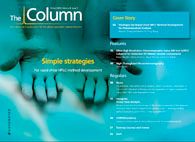Biofuel analysis
A team of scientists have developed a new analytical method to evaluate the quality of new renewable transportation fuels and intermediate organic liquid products (OLPs), as the current method has been developed for petroleum-based feedstocks and so is not suitable.

A team of scientists have developed a new analytical method to evaluate the quality of new renewable transportation fuels and intermediate organic liquid products (OLPs), as the current method has been developed for petroleum-based feedstocks and so is not suitable.1
The team developed a method for the detailed characterization of complex OLPs formed during triacylglyceride (TG) pyrolysis. This method was based on parallel identification using MS and quantification with FID. A programmed temperature vapourizer using a 25 °C, 0.1 min, 720 °C min-1, 350 °C, 5 min temperature programme was utilized, as this performed better than a split/splitless injector.
The new method identified and quantified over 250 species in OLPs generated from canola oil, soybean oil and canola methyl ester (CME). The method was also used to quantify polar, unidentified and unresolved species from previous studies. The mass balance was completed for samples derived from canola and soybean oil and all components were eluted during gas chromatography. The results were less clear-cut for the CME where only 77 wt% were characterized.
The study concluded that this method could potentially identify and measure all of the components in OLPs and thereby help with product development and commercialization of biofuels.
1. Alena Kubátová et al., Journal of Chromatography A, 1224, 79–88 (2012).
This story originally appeared in The Column. Click here to view that issue.
Evaluating the Accuracy of Mass Spectrometry Spectral Databases
May 12th 2025Mass spectrometry (MS) can be effective in identifying unknown compounds, though this can be complicated if spectra is outside of known databases. Researchers aimed to test MS databases using electron–ionization (EI)–MS.

.png&w=3840&q=75)

.png&w=3840&q=75)



.png&w=3840&q=75)



.png&w=3840&q=75)










